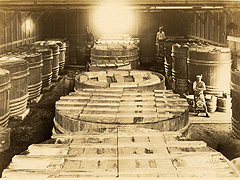
アクア・ユーカリ
男女入替え制で利用できる2つの大浴場には合計19種の湯船が揃う。和風と洋風で雰囲気が異なり、どちらにも入りたくなる。ほかにも、ボウリング場や卓球場、マンガや絵本が並ぶアクア文庫などもあり、多彩なレジャーが楽しめる。
Info
Business Hours
Price
Spot Category
The information provided reflects the details available at the time of the survey.
Please note that facility details may change due to the facility’s circumstances, so please check for the latest information before visiting.
This content has been translated using machine translation.
Information provided by: JTB Publishing
The content uses an automatic translation service, which is not always accurate.
The translated content may be different from the original meaning, so please understand and use it.

男女入替え制で利用できる2つの大浴場には合計19種の湯船が揃う。和風と洋風で雰囲気が異なり、どちらにも入りたくなる。ほかにも、ボウリング場や卓球場、マンガや絵本が並ぶアクア文庫などもあり、多彩なレジャーが楽しめる。

明治15年(1882)創業の和菓子店。名物の蔵六餅は餅の入った最中で、こし餡、つぶ餡、白餡の3種類があり、1個150円。佐倉藩主堀田家に伝わる亀甲模様の蔵六石にちなんだ菓子で、亀の甲をかたどった六角形をしている。湯を注いでおしることして食べることもできる。敷地内にある蔵では、古美術を展示している。時間は10~16時で、茶菓付550円。

創業明治20年(1887)、現在の社長で4代目を数える老舗。厳選した国産原料にこだわり、原料の大豆を煮るだけでなく、蒸すことで、色つやがよく、旨み成分を生かした味噌を作り出している。味噌汁の試飲もできる。

On the occasion of the Ojō Kōki, who was appointed as the lord of Osugasō, Shimousa Province, he was invited by Shinano Suwa Taisha Shrine as the god of the lord of the territory. He has since been revered as the god of industrial development, the god of wisdom, and in recent years as the god of advanced learning. The present main shrine is of the 1853 (Kaei 6) construction, and the annual festival "Sawara no Taisai (Autumn Festival)", which takes place in October every year, is designated as a national important intangible folk cultural property.

The temple of the Tendai sect, known as Narikiri (Namikiri), is a temple of the Tendai sect that collects the thick faith of the fishing people for great fishing prayers and sea protection. The main priest, Fudō Myōō, was reportedly picked up from the sea by the wives of the fishermen of the land during the middle Kamakura period and laid them here to rest. The thatched-roofed Fudō, which houses Fudō Myo, is designated as a national important cultural property, and is presumed to have been erected during the Muromachi period.

Western-style Mie-bashi, a masonry method, on the lower Nagao River at Takiguchi, Shirahama. Because there are three arches, it is not really glasses, but it has come to be called a glasses bridge from the appearance of moving to the river. The bridge was built in Meiji 21 (1888) with a donation of 399 yen and 40 yen from the villagers. He said he had walked across the river before the construction. It is a sturdy bridge that, in wartime, tanks passed through it without being broken by the Great Kanto Earthquake. Repair work was carried out in 1977 and 1993, and the figure remains at the time of construction. Prefectural Designated Tangible Cultural Property. Japan's Meihashi Hyakusyo.
This website uses cookies so that we can provide you with the best user experience possible. Cookie information is stored in your browser and performs functions such as recognising you when you return to our website and helping our team to understand which sections of the website you find most interesting and useful.
Strictly Necessary Cookie should be enabled at all times so that we can save your preferences for cookie settings.
If you disable this cookie, we will not be able to save your preferences. This means that every time you visit this website you will need to enable or disable cookies again.
